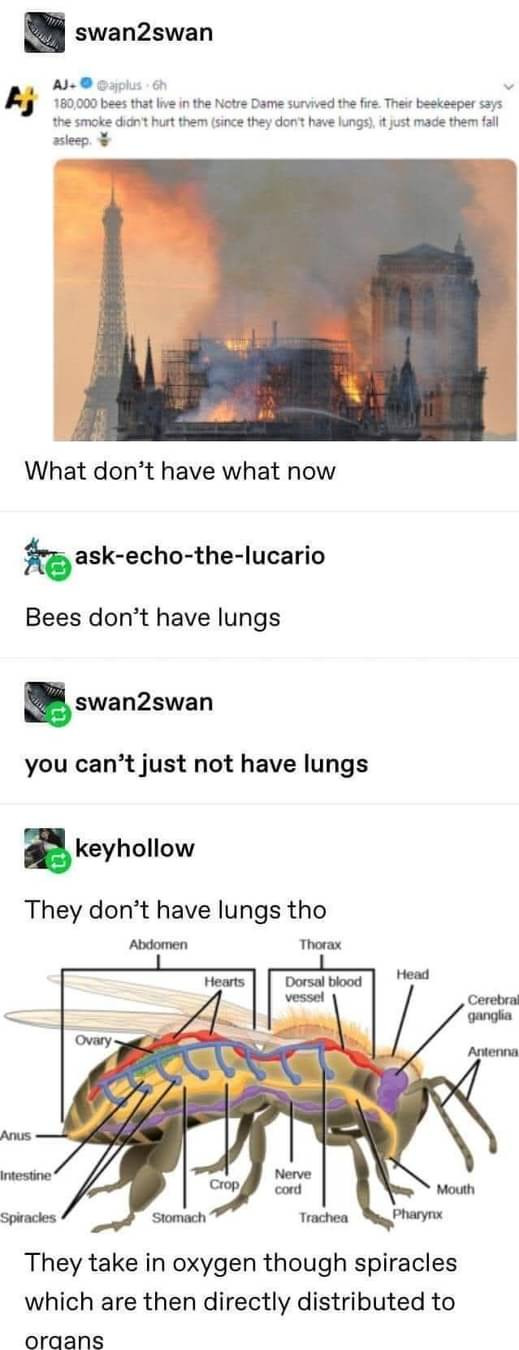So if I understand you correctly, if I remove my lungs, I’m a bee? My aunt had lung cancer, so they’ll probably kill me, anyway. I’ll report back on the results.
Science Memes
Welcome to c/science_memes @ Mander.xyz!
A place for majestic STEMLORD peacocking, as well as memes about the realities of working in a lab.

Rules
- Don't throw mud. Behave like an intellectual and remember the human.
- Keep it rooted (on topic).
- No spam.
- Infographics welcome, get schooled.
This is a science community. We use the Dawkins definition of meme.
Research Committee
Other Mander Communities
Science and Research
Biology and Life Sciences
- !abiogenesis@mander.xyz
- !animal-behavior@mander.xyz
- !anthropology@mander.xyz
- !arachnology@mander.xyz
- !balconygardening@slrpnk.net
- !biodiversity@mander.xyz
- !biology@mander.xyz
- !biophysics@mander.xyz
- !botany@mander.xyz
- !ecology@mander.xyz
- !entomology@mander.xyz
- !fermentation@mander.xyz
- !herpetology@mander.xyz
- !houseplants@mander.xyz
- !medicine@mander.xyz
- !microscopy@mander.xyz
- !mycology@mander.xyz
- !nudibranchs@mander.xyz
- !nutrition@mander.xyz
- !palaeoecology@mander.xyz
- !palaeontology@mander.xyz
- !photosynthesis@mander.xyz
- !plantid@mander.xyz
- !plants@mander.xyz
- !reptiles and amphibians@mander.xyz
Physical Sciences
- !astronomy@mander.xyz
- !chemistry@mander.xyz
- !earthscience@mander.xyz
- !geography@mander.xyz
- !geospatial@mander.xyz
- !nuclear@mander.xyz
- !physics@mander.xyz
- !quantum-computing@mander.xyz
- !spectroscopy@mander.xyz
Humanities and Social Sciences
Practical and Applied Sciences
- !exercise-and sports-science@mander.xyz
- !gardening@mander.xyz
- !self sufficiency@mander.xyz
- !soilscience@slrpnk.net
- !terrariums@mander.xyz
- !timelapse@mander.xyz
Memes
Miscellaneous
No because you’re likely too big (no offense) :(
I think insects have little holes all over their bodies, in which air gets inside by itself through some physics shenanigans. It doesn’t need to be actively sucked in like with lungs, it just happens because they’re so small.
This method doesn’t scale up though since if you’re bigger, you need more air, and having little holes all over your body won’t cut it. Thats when you know you need lungs, and that’s why you don’t see insects the size of a dog these days (thankfully).
There used to be times in the Earth’s history (Carboniferous) where the air’s composition was different though, and since it had more oxygen in it, insects could grow a lot larger.
Fun fact: Cutaneous respiration (aka "Skin breathing") is something we humans do too. But it accounts only for 1% to 2% of our oxygen input.
However, the cornea of our eyes doesn't have its own blood vessels to supply it. Therefore, it relies on direct gas exchange with the environment—in other words, skin respiration.
Our eyes breath like bees.
Is that why bees can't wear contact lenses?
No, it's because they have compound eyes. Even if they could afford all the different lenses they need, they'd never have enough time to put them in and take them out, while still working a full day.
surely they could just make one big lens with facets in it? sure they're gonna be hellishly expensive but at least they're usable
Honestly, I was already out of my depth with the entomology and ophthalmology discussed here. The economics of bee optometry might be a bridge too far for me. Can a bee make enough honey to afford such lenses? If so, does it improve the bee's ability to make honey enough to justify the cost? I have no idea and no clue regarding how to investigate this issue.
So what you're saying is I have two eyes in my beeholes?
I like this fact. That's why it's so important to take out certain kinds of contacts at night.
Adding to this, the holes (spiracles) connect to the tracheae, which connect to air sacs. While respiration is almost entirely passive in smaller species, larger species actually force air through the system to aid the otherwise passive process.
https://en.m.wikipedia.org/wiki/Respiratory_system_of_insects
Side note: Spiders have book lungs. They're not insects, but like insects, they are arthropods.
Yeah, and if you pluck a chicken, it will be a human, because it's featherless and stands on two legs.
That is almost how it works, but to really become a bee you'll have to turn the lungs into wings. Good luck. I'm looking forward to seeing the result.
And, for the most part, humans' lungs don't have bees!
I somehow forgot about bees not having lungs. I knew some other small things didn't.
Beekeepers intentionally use smoke to make bees docile during collection time, transfers, etc
However, what I've heard from a beekeeper is that the smoke triggers a flight response in them (from fire) so they consume honey ready to flee, and that's actual what makes them docile/drowsy.
You're telling me the bees get the munchies when they smoke...
This is (fortunately) why there's a maximum size on insects. The environment is less oxygen rich today than in the eras of giant insects in the past. They reach a size where oxygen can't penetrate deeply enough onto their bodies.
It's all based on a very fundamental mathematical law: if you increase the size of something, the volume increases with the third power while the surface area increases with the second power. An insect twice as large would be 8x as heavy and need 8x as much oxygen but 4x as much surface area.
That's also the reason why insects are as strong as they are. The strength of a muscle scales primarily with the cross section area of it, which again scales with the second power. So if you'd increase the weight of an ant by a factor 10,000,000 (e.g. 5mg to 50kg), the expected strength would increase by 10,000,000^(2/3) ≈ 46,400. If it could lift 10x it's weight at the original size, it could now only lift about 4.6% of it's weight
maybe once I have money for hobbies, but I really want to make oxygen rich terrariums, and selectively breed tarantulas to see if I can make them larger.
Insects don't have lungs. It also means their potential size is directly limited by the oxygen content in the air.
Which is why we don't see cat sized insects roaming around.
Which is why you don't see cat sized insects roaming around, I live next to a tarantula trail and some of them fuckers get BIG.
Spiders aren't insects. Though like them, they don't have lungs! Not ones like ours, anyway.
Hold on, wait a minute, pause. There are people who think that bugs have lungs?
To be fair, while bugs and other insects don't have lungs, some arthropods do. The differences among arthropods, insects and bugs aren't exactly common knowledge.
some have book-lungs not true lungs. Only us fish have "true" lungs
edit: this thread turned into nerd-heaven. i love it!
Agreed. I was referring to book lungs.
Also, I feel like you got some 'splainin' to do regarding the fish reference.
It's funny that this is biology in 4th grade and half the people here are shocked
Hunh. TIL.
Not just bees, it's true of all insects.
Consequently, the amount of oxygen in the air determines how big bugs can grow. Get too big, and the oxygen can't diffuse into the body fast enough. This even shows up in the fossil records, with larger bugs being found alongside evidence of eras that had more oxygen in the atmosphere.
They aren't insects, but most arachnids have book lungs, which are basically a pocket full of air gills.
It's what limits their size. If insects had lungs, they could get larger. 300 million years ago, when the oxygen content in the atmosphere was temporarily higher, there were huge dragonflies with 75 cm wingspan (2.5 ft).
In the original Jurassic Park novel by Michael Crichton, one of the animals they've cloned are these giant dragonflies. Its only one line in the book (Tim, one if the kids, sees one fly by and recalls reading about them) but it caught my attention as just straight impossible. I remember thinking, "Unless you're somehow controlling the oxygen level of the air around this entire island, there's no way that bug can't breathe."
they don't have circulatory systems either they've basically just pushing things through themselves and tryna make it work
Pedant here. They absolutely do have circulatory systems. They have what's known as an open circulatory system, whereas we have a closed circulatory system.
"I've been trying to quit smoking. I want to take better care of my spiracles"
Wait until this person hears about fish.
